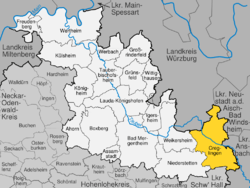Creglingen
Creglingen is a town in the Main-Tauber district of Baden-Württemberg, Germany. It has around 4,700 inhabitants.
Creglingen | |
|---|---|
 Coat of arms | |
Location of Creglingen within Main-Tauber-Kreis district  | |
 Creglingen  Creglingen | |
| Coordinates: 49°28′N 10°2′E | |
| Country | Germany |
| State | Baden-Württemberg |
| Admin. region | Stuttgart |
| District | Main-Tauber-Kreis |
| Government | |
| • Mayor | Uwe Hehn |
| Area | |
| • Total | 117.22 km2 (45.26 sq mi) |
| Elevation | 278 m (912 ft) |
| Population (2018-12-31)[1] | |
| • Total | 4,694 |
| • Density | 40/km2 (100/sq mi) |
| Time zone | CET/CEST (UTC+1/+2) |
| Postal codes | 97993, 97990 (Standorf |
| Dialling codes | 07932, 07933, 07939, 09335, 09865 |
| Vehicle registration | TBB, MGH |
| Website | www.creglingen.de |
Geography
Subdivision
The town Creglingen contains the following Districts (since the municipal reform of 1972): Archshofen, Blumweiler, Craintal, Erdbach, Finsterlohr (together with the villages Schonach, Burgstall and Seldeneck), Frauental, Freudenbach, Münster, Niederrimbach, Oberrimbach, Lichtel, Reinsbronn (together with the village of Niedersteinach), Reutsachsen, Schirmbach, Schmerbach, Schön, Schwarzenbronn, Waldmannshofen (together with the village of Sechselbach and the hamlets Fuchshof und Seewiesenhof), Wolfsbuch, Weiler.
History
_Riemenschneideraltar_2014-09-23-113.jpg)
The Celts who founded the town between 200 and 100 B.C. also farmed the surrounding plateaus and valleys. In 1349, Creglingen received its town charter from Emperor Karl IV (Charles IV).
Attractions
Creglingen is known for the Herrgottskirche outside of the town. It contains a masterwork of late-Gothic sculpture by Tilman Riemenschneider, the Marienaltar. The church is a pilgrimage chapel, established following a reported discovery of an undamaged communion wafer by a peasant ploughing his field in 1384. This wafer was thought to be the cause of miracles and people flocked to the site. The local lords, Konrad and Gottfried von Hohenlohe-Brauneck, had a Gothic chapel built in 1386–96. At the pilgrimage's peak around 1500 a number of altars were ordered that remain in the church today. The central altar by Riemenschneider was built on the spot where the wafer was reportedly found. The figures are made from the wood of linden trees, the surrounding frames from pine trees. At a total height of 11 meters the altar dominated the small church. Although Reformation reached the area in 1530, its iconoclasm spared the local church. The altar wings of the main altar were closed, however, as the depicted Assumption of Mary was offensive to the Protestant congregations. Its good state of preservation is owed to the fact that the wings of the altar remained closed and the whole was covered by funeral wreaths until 1832.[2]:121–2
Notable people
- Crago (Alamanni)), mythical founder
- Gustav Vorherr (1778-1847), architect and economist, Royal Bavarian Baurat
- Georg Pflüger (1835-1896), member of the Reichstag
- Wilhelm Michler (1846-1899), chemist
- Hermann Stern (1866-1933), Holocaust victim
- Manfred Hollenbach (born 1946), mayor, politician (CDU), Member of the Landtag of Baden-Württemberg
- Helmut Böttiger (born 1956), writer, literary critic and essayist
References
- "Bevölkerung nach Nationalität und Geschlecht am 31. Dezember 2018". Statistisches Landesamt Baden-Württemberg (in German). July 2019.
- Dettelbacher, Werner (1974). Franken - Kunst, Geschichte und Landschaft (German). Dumont Verlag. ISBN 3-7701-0746-2.